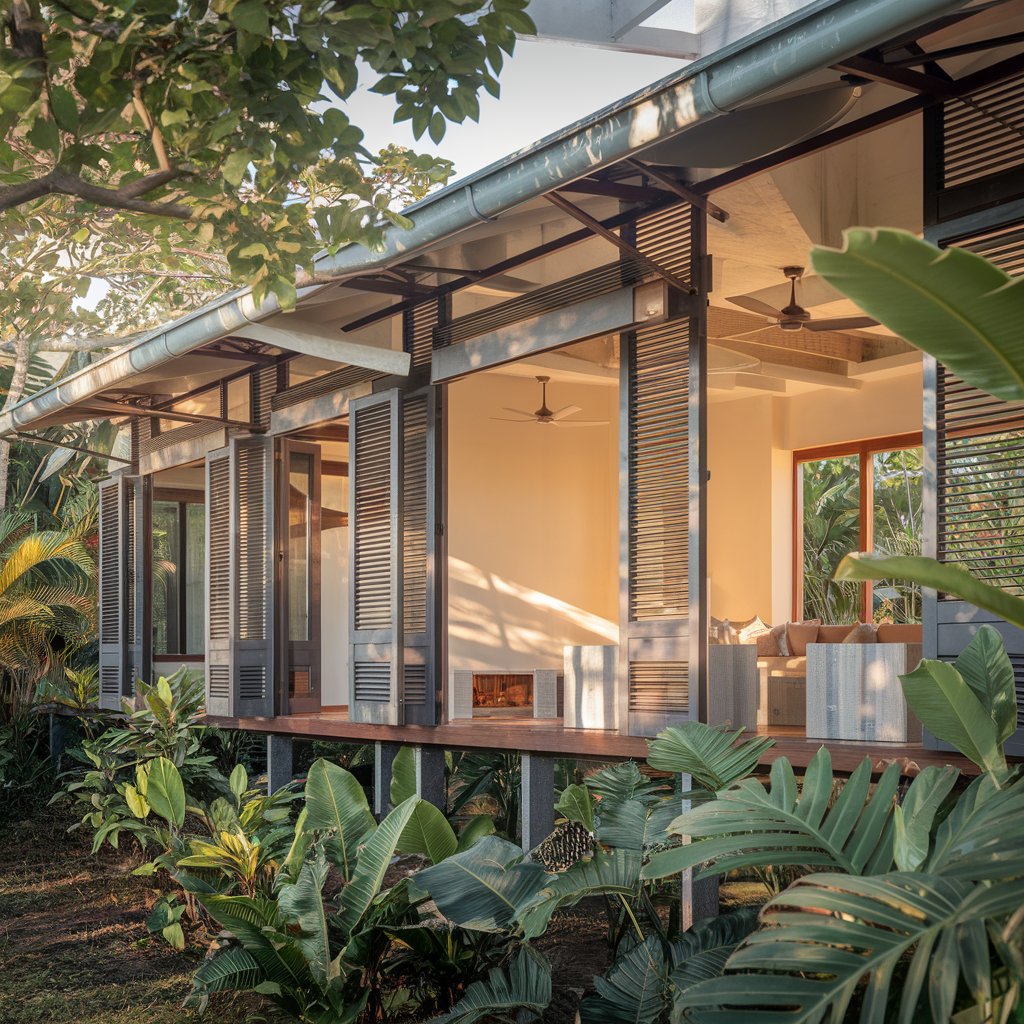MISHub QI
Ventilation and Thermal Comfort Systems for Tropical Buildings
Ventilation and Thermal Comfort Systems for Tropical Buildings
Mozambique, located in the tropical region of the southern hemisphere, has a predominantly hot and humid climate, characterized by high temperatures and seasonal rainfall. This scenario makes it essential to use ventilation systems and strategies for thermal comfort in buildings, adapted to local climatic conditions. Natural ventilation, combined with strategic architectural elements, can significantly improve the quality of life of residents, reducing energy costs and environmental impact.
1. Importance of Ventilation and Thermal Comfort
- Ventilation : Essential for removing hot, humid air from indoor environments, reducing the feeling of stuffiness and improving air quality. [1]
- Thermal Comfort : Refers to the sensation of thermal well-being of people within a space, influenced by factors such as temperature, humidity and air movement. [2]
2. Compartments and Ventilation
Each space within a building has specific ventilation needs:
2.1. Living Rooms and Living Areas [3]
- Number of Windows : At least two windows, positioned on opposite or adjacent walls, to allow cross ventilation.
- Position : They should be facing the predominant wind directions (Southeast in Mozambique).
2.2. Rooms [4]
- Size and Position : Smaller windows, positioned to capture the morning breeze and keep out the afternoon heat.
- Orientation : Orienting bedrooms to the southeast, although favorable for ventilation and thermal comfort, can pose challenges in tropical regions such as Mozambique, due to prevailing winds and horizontal rain that can cause infiltration and structural wear. Mitigation strategies, such as sealed windows, brise-soleil and waterproof coatings, are essential. Alternatively, orientation to the northeast is recommended as it offers soft morning sunlight and less exposure to severe weather conditions, ensuring a better balance between comfort and protection. The decision should consider the local microclimate and construction materials.
2.3. Kitchens and Bathrooms [5]
- Forced or Natural Ventilation : Kitchens require chimneys or extractor fans. Bathrooms require ventilation grilles or tilt-and-turn windows to expel humidity.
2.4. Service Areas [6]
- Strategic Openings : Use of ventilated coverings or brise-soleils to facilitate the escape of heat generated by equipment.
3. Influence of Zone and Climate
3.1. Coastal Regions [7]
- Impact of the Sea : More constant winds and high humidity require corrosion-resistant materials and systems that facilitate continuous air circulation.
- Strategies : Use of large windows and sliding panels.
3.2. Inland Regions
- Thermal Variation : Greater oscillation between day and night requires walls with good thermal inertia and controllable openings.
- Strategies : Adjustable blinds and cross ventilation.
4. Type of Construction and Number of Floors
4.1. Single-story residences
- Natural Ventilation : More effective due to proximity to air currents.
- Openings : Wide to facilitate air circulation.
4.2. Multi-storey buildings
- Rising Air Currents : Upper floors receive greater wind incidence, being ideal for passive ventilation.
- Ventilation Ducts : Essential for balancing air circulation on lower floors.
5. Architectural Strategies for Tropical Climates
5.1. Roofs and Coverings [8]
- Ventilated Roofs : Use of wide eaves and systems that allow air circulation between the roof and the lining.
- Materials : Preference for light or reflective tiles.
5.2. Shading and Sun Protection [9]
- Brise-soleils and Balconies : Reduce direct sunlight, keeping the indoor environment cooler.
- Trees : Strategically planted to create barriers against the heat.
5.3. Walls and Facades
- Double Walls : Increase thermal insulation.
- Use of Local Materials : Cement or stone blocks can be combined to improve thermal efficiency.
6. Seasons and Seasonal Adjustments [10]
6.1. Rainy Season (Summer)
- Attention to Humidity : It is necessary to ensure good ventilation to avoid mold and condensation.
- Windows with Screens : Protect against insects while maintaining ventilation.
6.2. Dry Season (Winter)
- Control of Cold Wind Entry : Use of adjustable louvers to limit excessive drafts.
- Passive Heating : Allowing more sunlight to enter during the day.
7. Advantages of a Proper Ventilation System [11]
- Reduction in Energy Costs : Less dependence on air conditioning or fans.
- Environmental Comfort : Cooler and more pleasant environments.
- Occupant Health : Improved indoor air quality, reducing respiratory problems.
- Sustainability : Contribution to ecologically responsible construction practices.
Conclusion
Designing ventilation and thermal comfort systems for tropical buildings in Mozambique requires attention to several factors, from the climate and geographic location to the specific characteristics of each compartment. The combination of efficient natural ventilation, appropriate materials and shading strategies results in buildings that are more comfortable, sustainable and suited to the needs of residents. The success of these systems is directly linked to the understanding of local particularities and the application of good design practices.
Bibliographic References
[1] Awbi, HB Ventilation for Building . CRC Press, 2013.
[2] ASHRAE. Standard 55-2020: Thermal Environmental Conditions for Human Occupancy . Atlanta: ASHRAE, 2020.
[3] Givoni, B. Climate Considerations in Building and Urban Design . Wiley, 1998.
[4] Olgyay, V. Design with Climate: Bioclimatic Approach to Architectural Regionalism . Princeton University Press, 2015.
[5] Koenigsberger, OH, et al. Manual of Tropical Housing and Building . London: Longman, 1973.
[6] Wiley, J. Green Building Design Guide . New York: Wiley, 2009.
[7] Snow, J. Building Design for Coastal Regions . New York: Architecture Press, 2005.
[8] Lloyd, F. Roofing Design and Application . London: Wiley, 2003.
[9] Pelss, A. Shading Strategies for Building Design . Amsterdam: Elsevier, 2017.
[10] Saha, TK Tropical Sustainable Architecture . London: Elsevier, 2013.
[11] Walker, SB Sustainable Building Design Principles . Oxford: Oxford University Press, 2015.
[12] Forjaz, J.; Correia, MDAB Sustainable Architecture in Mozambique: Manual of Good Practices. CPLP, 2011.
Authors: Eng. Francisco Quisele Jr .; Architect Ângelo Luís
Date of publication : 11/26/24
Share


